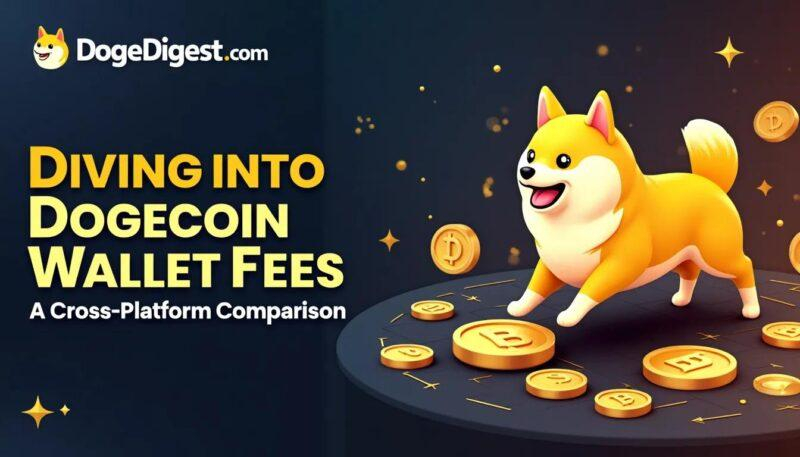In the ever-evolving world of cryptocurrencies, Dogecoin has surged from a lighthearted meme coin to a serious contender in digital finance. As enthusiasts and investors dive into Dogecoin transactions, one often overlooked yet crucial element emerges: wallet fees. These seemingly small charges can accumulate, influencing the overall cost and convenience of managing Dogecoin assets. This article sets out to explore and compare Dogecoin wallet fees across various platforms, shedding light on how each handles transaction costs and what users can expect when navigating this playful yet practical cryptocurrency.
Understanding Dogecoin Wallet Fees and Their Impact on Transactions
When navigating Dogecoin transactions, understanding wallet fees is paramount. These fees aren’t arbitrarily set; they stem from network demand and transaction size. Wallet providers often pass on these fees differently-some absorb a portion, while others add a markup, impacting the final transaction cost. Recognizing this subtle variation helps users avoid unexpected charges and optimize transaction timing.
Wallet fee structures vary widely across platforms, influenced by factors like user experience focus, security measures, and transaction speed preferences. For instance, custodial wallets might streamline fees through batch processing, lowering costs but at the expense of fewer personal confirmations. Conversely, non-custodial wallets grant users more control but require vigilant fee selection to ensure timely confirmations.
| Wallet Type | Fee Model | Average Fee (DOGE) | Transaction Speed |
|---|---|---|---|
| Custodial | Fixed + Variable | 0.01 | Fast |
| Non-Custodial | User-selected | 0.001 – 0.02 | Variable |
| Mobile Wallet | Dynamic | 0.005 | Moderate |
| Hardware Wallet | Manual | 0.002 – 0.015 | User-Dependent |
Key considerations when managing Dogecoin wallet fees include:
- Transaction urgency vs. cost: Higher fees typically accelerate confirmations.
- Wallet fee transparency: Clear fee breakdowns empower smarter choices.
- Network congestion periods: Timing transactions during low activity can slash fees.
Comparative Analysis of Fee Structures Across Popular Dogecoin Wallets
Dogecoin wallets vary significantly when it comes to their fee structures, often influencing user choice more than expected. While some wallets integrate fixed fees regardless of transaction size, others opt for dynamic fees dictated by network congestion or transaction priority. For instance, multi-currency wallets tend to have higher base fees due to added layers of security and convenience, whereas dedicated Dogecoin wallets often boast lower or more transparent fee systems.
Beyond the core transaction fee, many wallets incorporate additional costs that users should be aware of. These might include:
- Withdrawal fees when moving Dogecoin off-platform
- Conversion fees
- Priority fees for faster transaction confirmation
Identifying these nuances can save users unexpected expenses. Wallets like Dogecoin Core stick to minimalist fee models focused solely on network fees, while custodial wallets often bundle multiple fee types into their service charges.
| Wallet | Base Transaction Fee | Additional Fees | Priority Options |
|---|---|---|---|
| Dogecoin Core | 0.01 DOGE | None | Customizable |
| Trust Wallet | 0.02 DOGE | 0.5% Conversion | Standard Only |
| Atomic Wallet | Variable* | 0.1 DOGE Withdrawal | High Priority (+fee) |
| Exodus | Dynamic (avg. 0.015 DOGE) | None | Custom Fee Available |
*Variable fees depend on network congestion and can fluctuate significantly throughout the day.
Hidden Costs and Unexpected Charges to Watch Out For
When managing your Dogecoin across various wallets, it’s easy to focus solely on visible fees like transaction costs, but many users overlook the subtle, hidden expenses that quietly chip away at their holdings. Some wallets impose maintenance fees for account upkeep or charge for features that appear standard, such as enhanced security layers or real-time market tracking. These charges, though often small, can accumulate over time, especially for frequent traders or long-term holders.
Then there’s the issue of currency conversion surcharges. Not all wallets offer seamless Dogecoin exchanges, and some apply extra fees when converting Dogecoin to fiat or other cryptocurrencies. This can particularly affect users who regularly move funds between platforms or need liquidity in other currencies. Watching out for wallets that either hide these conversion fees in poor exchange rates or slap on upfront percentages is crucial for optimizing your Dogecoin’s value.
Let’s break down a few common hidden charges you might encounter:
- Withdrawal Fees: Not always transparent; some wallets charge a fixed fee when you move Dogecoin out.
- Inactivity Penalties: Rare but real – wallets may deduct fees if your account remains dormant.
- Upgrade Charges: Premium wallet features can come at unexpected costs, especially in subscription models.
| Hidden Cost Type | Potential Impact | How to Avoid |
|---|---|---|
| Withdrawal Fees | Reduces transfer amount | Check wallet withdrawal policies |
| Inactivity Penalties | Gradual balance erosion | Regular activity or wallet switch |
| Upgrade Charges | Unexpected monthly costs | Evaluate necessity before upgrading |
Optimizing Your Dogecoin Transactions to Minimize Fees
When dealing with Dogecoin transactions, strategic timing is essential to keep fees low. Since Dogecoin’s network experiences fluctuating congestion similar to other cryptocurrencies, executing transfers during off-peak hours can decrease competition for block space. This simple adjustment often results in significantly lower fees, allowing you to stretch your wallet further without compromising transaction speed.
Additionally, consider customizing your fee rates instead of accepting default suggestions from wallets. Many Dogecoin wallets offer the option to set manual fees based on priority. Selecting a “low” or “economy” fee setting may increase confirmation time but can reduce costs dramatically-especially for non-urgent transactions. Here are a few tips to keep your fees optimized:
- Batch multiple transactions together to save on per-transaction fees.
- Avoid small “dust” transfers that often incur disproportionate fees.
- Stay updated on Dogecoin network status via explorers or forums.
To give a clearer picture, the table below compares average fee ranges across popular wallets when setting “economy” fees:
| Wallet | Average Economy Fee (DOGE) | Typical Confirmation Time |
|---|---|---|
| DogeCoin Core | 0.0015 | 15-30 min |
| Atomic Wallet | 0.0012 | 20-40 min |
| Trust Wallet | 0.0010 | 25-45 min |
Choosing the Right Wallet for Cost-Effective Dogecoin Management
When managing Dogecoin efficiently, the wallet you pick can make a significant impact on your overall costs. While many popular wallets offer seamless functionality, some stand out due to their minimal fees or innovative fee structures designed specifically for low-cost transactions. Prioritize wallets that provide clear breakdowns of fees upfront and allow you to adjust transaction priorities-this flexibility can save you big in the long haul especially during network congestion.
Key features to consider include:
- Low or no deposit fees: Some wallets charge fees just to hold or receive Dogecoin, so opting for zero-fee wallets can boost your cost efficiency.
- Adjustable transaction fees: Wallets allowing manual fee settings help you balance speed with cost.
- Integration with multiple platforms: Cross-platform compatibility means easier management where you need it most-whether on desktop, mobile, or web.
| Wallet | Deposit Fee | Tx Fee Flexibility | Platform Support |
|---|---|---|---|
| Dogecoin Core | None | Manual | Desktop |
| Exodus | None | Automatic | Desktop, Mobile |
| Atomic Wallet | None | Manual | Desktop, Mobile |
| Trust Wallet | None | Manual | Mobile |
| Ledger Live (Hardware) | None | Manual | Desktop, Mobile |
Q&A
Q&A: Diving into Dogecoin Wallet Fees – A Cross-Platform Comparison
Q1: What exactly are Dogecoin wallet fees?
A: Dogecoin wallet fees are the transaction costs users pay to send Dogecoin (DOGE) from one wallet to another. These fees compensate miners who validate and record transactions on the Dogecoin blockchain, helping maintain the network’s security and speed.
Q2: Why do Dogecoin wallet fees vary across different platforms?
A: Fees can differ depending on the wallet’s design, its fee structure, and whether it dynamically adjusts fees based on network congestion. Some wallets prioritize faster confirmations by charging higher fees, while others aim for cost-efficiency with lower fees but potentially slower transaction times.
Q3: Are the fees for sending Dogecoin generally high?
A: Compared to many cryptocurrencies, Dogecoin fees tend to be relatively low due to its lightweight blockchain and efficient mining process. However, during peak times, fees can spike slightly, especially on certain platforms that use fixed fee rates.
Q4: How do custodial and non-custodial wallets differ in terms of fees?
A: Custodial wallets, like those provided by exchanges, might bundle fees into their services or charge additional handling fees. Non-custodial wallets usually charge only the network fee, giving users more transparency and control over transaction costs.
Q5: Which Dogecoin wallets offer the most competitive fees?
A: Lightweight, non-custodial wallets like Dogecoin Core or multi-currency wallets such as Exodus often provide flexible fee settings, allowing users to choose between speed and cost. Mobile wallets sometimes add convenience fees, so it’s worth comparing based on your priorities.
Q6: Can users customize their transaction fees on Dogecoin wallets?
A: Yes, many wallets allow users to adjust fees manually. Setting a higher fee typically speeds up transaction confirmation, while lower fees may delay processing. This flexibility helps users balance cost and transaction speed according to their needs.
Q7: How does network congestion impact Dogecoin wallet fees?
A: When many transactions flood the Dogecoin network, miners prioritize those with higher fees, driving fees upwards. During these times, some wallets increase minimum fees or suggest higher amounts to ensure timely processing.
Q8: Are there hidden or additional fees to watch out for?
A: While network fees are transparent, some platforms may include extra charges, such as withdrawal fees or service fees. It’s essential to review wallet and exchange terms carefully, especially if you’re moving DOGE frequently or in large amounts.
Q9: What should users consider when choosing a Dogecoin wallet based on fees?
A: Users should consider transaction frequency, desired speed, fee transparency, and whether the wallet offers fee customization. Balancing convenience, control, and cost is key to a satisfying wallet experience.
Q10: Where can I find up-to-date information about Dogecoin wallet fees?
A: Checking official wallet websites, user reviews, and blockchain explorers can provide real-time fee details. Communities and forums dedicated to Dogecoin also often share insights into current trends and fee comparisons across platforms.
This Q&A offers a broad overview to help users navigate the nuanced landscape of Dogecoin wallet fees, empowering smarter choices across different wallet platforms.
To Wrap It Up
As we’ve seen, Dogecoin wallet fees vary not only by platform but also by the choices users make within each ecosystem. Whether you prioritize speed, security, or cost-efficiency, understanding these nuances can help you navigate the Dogecoin landscape with greater confidence. In the ever-evolving world of cryptocurrencies, staying informed about fee structures is more than just a matter of saving cents-it’s about making smart decisions that align with your goals. So next time you’re ready to send or receive Dogecoin, remember: a little knowledge about wallet fees can go a long way in maximizing the value of your digital journey.




